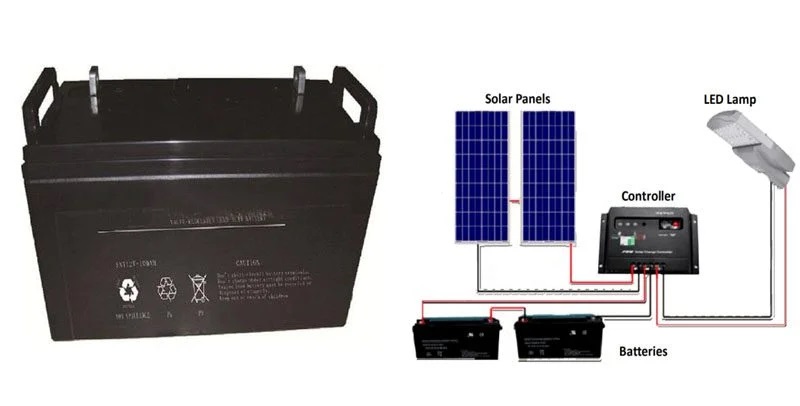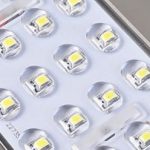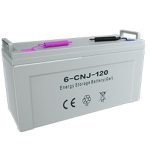Why is the use of lithium batteries for solar street lights now the industry standard?

Why are solar street lights now equipped with lithium batteries as standard? It turns out that lead-acid batteries fail so easily!
As the main energy storage device for solar street lights, batteries are commonly used today. Lithium iron phosphate batteries are commonly used. This kind of battery is superior to gel batteries in terms of discharge depth, charging time, and battery specific energy.
lithium batteries for solar street lights
Another very important point is that the life of the colloidal lead-acid battery is very short. The experience when using it is naturally not as good as that of the lithium iron phosphate battery. So, why is the life of the colloidal battery so short?

What is a gel battery?
Compared with traditional lead-acid batteries, the most obvious difference is that the gel battery changes the electrolyte into a gel form. In terms of performance, it is naturally superior to traditional lead-acid batteries in many aspects, but in essence, it It is still a lead-acid battery, so many of the reasons that lead to the short life of traditional lead-acid batteries will also reduce the operation of gel batteries and cause their failure, but the degree is different.

Reasons for battery failure
1. Vulcanization
The charging and discharging process of this kind of battery is achieved through electrochemical reactions. In this process, lead sulfate is generated during discharge, and lead sulfate is reduced to aluminum oxide during charging. Although this process is cyclic and reversible, it requires Note that lead sulfate is a crystalline substance that is easily salinized.
This substance has large particles and low activity. It is difficult to convert into active substances during charging, destroying the original reversible cycle, and cannot be reduced to aluminum oxide, causing the battery’s function to decline.
On the other hand, the crystallized lead sulfate will also be adsorbed on the grid, resulting in a reduction in the working area of the grid, which in turn will cause the battery to heat up, lose water, and reduce capacity. This situation is usually called sulfuration. In layman’s terms, it is also called vulcanization. It’s just aging.
The reasons for this are usually that the battery has been stored for a long time (more than 3 months) before installation and use, continuous over-discharge or frequent over-discharge or low-current deep discharge, ambient temperature is too high or too low, frequent undercharging and Leveling is not performed regularly.
2. Loss of water
One of the most basic principles of battery operation is that after the positive plate generates oxygen, the oxygen goes directly to the negative plate and the hydrogen generated on the negative plate is reduced to water, forming an oxygen cycle process. In the past, if traditional lead-acid batteries wanted to continue to be used, they had to For regular maintenance, there is a process of adding water.
Later, sealed lead-acid batteries appeared, which can reduce the water loss of lead-acid batteries. The same is true for gel batteries. However, if the battery is not used correctly, water loss will still occur.
For example, turning on the power frequently, charging the battery frequently, or the environment is too high. High temperature is the main factor causing the battery to lose water, which will accelerate the water loss of the battery, thereby leading to a reduction in battery capacity. Generally speaking, the battery loses 10% of water. , the capacity will drop by 20%, water loss will be 25%, and the battery life will basically come to an end.
Although the electrolyte density of gel batteries is lower than that of traditional lead-acid sealed batteries, and the capacity is 15% to 25% higher. The possibility of water loss is lower, but the possibility of water loss still exists, so there is still this factors causing battery failure.
As mentioned above, the battery will have an oxygen cycle process when it is working. The oxygen cycle will generate heat. Although the sealed design slows down the water loss, it may also cause the heat generated during the charging process to be delayed. Released, it is easier to enter a state of thermal runaway.
This situation will have a devastating impact on the battery, causing the battery shell to deform, and in more serious cases, the battery may explode. Generally, this situation occurs because the working environment temperature of the battery is too high, such as exceeding 45°C, or The float charge voltage is too high at high temperatures, and the battery itself has no temperature compensation function. Another situation is that the charging current exceeds the design value.
, the grids of some relatively poor gel batteries still use low antimony alloys, which reduces the hydrogen evolution voltage of the negative plate and makes the internal pressure of the battery higher, making the battery more susceptible to thermal runaway. Better battery manufacturers all use lead-calcium series alloys. , and mitigate early capacity loss by using high tin.
In addition
The grids of some relatively poor gel batteries still use low antimony alloys, which reduces the hydrogen evolution voltage of the negative plate and makes the internal pressure of the battery higher, making the battery more susceptible to thermal runaway. Better battery manufacturers all use lead-calcium series alloys. , and mitigate early capacity loss by using high tin.
Author

ZGSM Solar
We are a professional solar street light manufacturer with a 20-year history.






